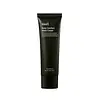What's inside
What's inside
 Key Ingredients
Key Ingredients

 Benefits
Benefits

 Concerns
Concerns

 Ingredients Side-by-side
Ingredients Side-by-side

Water
Skin ConditioningGlycerin
HumectantGlyceryl Stearate Citrate
EmollientCetearyl Alcohol
EmollientPanthenol
Skin ConditioningAllantoin
Skin ConditioningGlyceryl Stearate
EmollientSucrose Stearate
EmollientEthylhexyl Palmitate
EmollientGlycine Soja Oil
EmollientMel
EmollientVitis Vinifera Seed Oil
EmollientBenzyl Alcohol
PerfumingCaprylic/Capric Triglyceride
MaskingPassiflora Edulis Seed Oil
EmollientPunica Granatum Seed Oil
EmollientSodium Hydroxide
BufferingXanthan Gum
EmulsifyingSalix Alba Bark Extract
AstringentSalicylic Acid
MaskingTocopheryl Acetate
AntioxidantSorbic Acid
PreservativeWater, Glycerin, Glyceryl Stearate Citrate, Cetearyl Alcohol, Panthenol, Allantoin, Glyceryl Stearate, Sucrose Stearate, Ethylhexyl Palmitate, Glycine Soja Oil, Mel, Vitis Vinifera Seed Oil, Benzyl Alcohol, Caprylic/Capric Triglyceride, Passiflora Edulis Seed Oil, Punica Granatum Seed Oil, Sodium Hydroxide, Xanthan Gum, Salix Alba Bark Extract, Salicylic Acid, Tocopheryl Acetate, Sorbic Acid
Water
Skin ConditioningGlycerin
HumectantCaprylic/Capric Triglyceride
MaskingHelianthus Annuus Seed Oil
EmollientUndecane
EmollientPolyglyceryl-3 Distearate
Emulsifying1,2-Hexanediol
Skin ConditioningTridecane
PerfumingStearyl Alcohol
EmollientButyrospermum Parkii Butter
Skin ConditioningHydrogenated Lecithin
EmulsifyingGlyceryl Stearate Citrate
EmollientTrehalose
HumectantBetula Platyphylla Japonica Bark Extract
Skin ConditioningOrbignya Oleifera Seed Oil
EmollientPanthenol
Skin ConditioningPantolactone
HumectantPentylene Glycol
Skin ConditioningButylene Glycol
HumectantTocopherol
AntioxidantAlanine
MaskingArginine
MaskingCysteine
AntioxidantGlycine
BufferingHistidine
HumectantIsoleucine
Skin ConditioningLeucine
Skin ConditioningLysine
Skin ConditioningMethionine
Skin ConditioningPhenylalanine
MaskingProline
Skin ConditioningSerine
MaskingThreonine
Tyrosine
MaskingValine
MaskingAspartic Acid
MaskingGlutamic Acid
HumectantHyaluronic Acid
HumectantHydrolyzed Hyaluronic Acid
HumectantHydrolyzed Sodium Hyaluronate
Skin ConditioningHydroxypropyltrimonium Hyaluronate
Potassium Hyaluronate
Skin ConditioningSodium Hyaluronate
HumectantSodium Hyaluronate Crosspolymer
HumectantSodium Acetylated Hyaluronate
HumectantArachidyl Alcohol
EmollientBehenyl Alcohol
EmollientCetyl Alcohol
EmollientAcrylates/C10-30 Alkyl Acrylate Crosspolymer
Emulsion StabilisingTetrasodium EDTA
Tetrasodium Iminodisuccinate
Tromethamine
BufferingCarbomer
Emulsion StabilisingBehenic Acid
CleansingMyristic Acid
CleansingStearic Acid
CleansingEthylhexylglycerin
Skin ConditioningWater, Glycerin, Caprylic/Capric Triglyceride, Helianthus Annuus Seed Oil, Undecane, Polyglyceryl-3 Distearate, 1,2-Hexanediol, Tridecane, Stearyl Alcohol, Butyrospermum Parkii Butter, Hydrogenated Lecithin, Glyceryl Stearate Citrate, Trehalose, Betula Platyphylla Japonica Bark Extract, Orbignya Oleifera Seed Oil, Panthenol, Pantolactone, Pentylene Glycol, Butylene Glycol, Tocopherol, Alanine, Arginine, Cysteine, Glycine, Histidine, Isoleucine, Leucine, Lysine, Methionine, Phenylalanine, Proline, Serine, Threonine, Tyrosine, Valine, Aspartic Acid, Glutamic Acid, Hyaluronic Acid, Hydrolyzed Hyaluronic Acid, Hydrolyzed Sodium Hyaluronate, Hydroxypropyltrimonium Hyaluronate, Potassium Hyaluronate, Sodium Hyaluronate, Sodium Hyaluronate Crosspolymer, Sodium Acetylated Hyaluronate, Arachidyl Alcohol, Behenyl Alcohol, Cetyl Alcohol, Acrylates/C10-30 Alkyl Acrylate Crosspolymer, Tetrasodium EDTA, Tetrasodium Iminodisuccinate, Tromethamine, Carbomer, Behenic Acid, Myristic Acid, Stearic Acid, Ethylhexylglycerin
 Reviews
Reviews

Ingredients Explained
These ingredients are found in both products.
Ingredients higher up in an ingredient list are typically present in a larger amount.
This ingredient is an emollient, solvent, and texture enhancer. It is considered a skin-softener by helping the skin prevent moisture loss.
It helps thicken a product's formula and makes it easier to spread by dissolving clumping compounds.
Caprylic Triglyceride is made by combining glycerin with coconut oil, forming a clear liquid.
While there is an assumption Caprylic Triglyceride can clog pores due to it being derived from coconut oil, there is no research supporting this.
Learn more about Caprylic/Capric TriglycerideGlycerin is already naturally found in your skin. It helps moisturize and protect your skin.
A study from 2016 found glycerin to be more effective as a humectant than AHAs and hyaluronic acid.
As a humectant, it helps the skin stay hydrated by pulling moisture to your skin. The low molecular weight of glycerin allows it to pull moisture into the deeper layers of your skin.
Hydrated skin improves your skin barrier; Your skin barrier helps protect against irritants and bacteria.
Glycerin has also been found to have antimicrobial and antiviral properties. Due to these properties, glycerin is often used in wound and burn treatments.
In cosmetics, glycerin is usually derived from plants such as soybean or palm. However, it can also be sourced from animals, such as tallow or animal fat.
This ingredient is organic, colorless, odorless, and non-toxic.
Glycerin is the name for this ingredient in American English. British English uses Glycerol/Glycerine.
Learn more about GlycerinGlyceryl Stearate Citrate is a citric acid ester of glyceryl stearate.
It is an emulsifier, emollient, and a surfactant.
Emulsifiers help stabilize a product. It does this by preventing certain ingredients from separating. Common ingredients include oils and water, which do not mix naturally. Emulsifiers have properties that help keep ingredients such as these together.
Emollients help soothe and soften the skin. They do this by creating a protective film on your skin. This barrier helps trap moisture and keeps your skin hydrated. Emollients may be effective at treating dry or itchy skin.
Surfactants help gather oils, dirt, and other pollutants from the skin. This helps them to be easily rinsed away.
Learn more about Glyceryl Stearate CitratePanthenol is a common ingredient that helps hydrate and soothe the skin. It is found naturally in our skin and hair.
There are two forms of panthenol: D and L.
D-panthenol is also known as dexpanthenol. Most cosmetics use dexpanthenol or a mixture of D and L-panthenol.
Panthenol is famous due to its ability to go deeper into the skin's layers. Using this ingredient has numerous pros (and no cons):
Like hyaluronic acid, panthenol is a humectant. Humectants are able to bind and hold large amounts of water to keep skin hydrated.
This ingredient works well for wound healing. It works by increasing tissue in the wound and helps close open wounds.
Once oxidized, panthenol converts to pantothenic acid. Panthothenic acid is found in all living cells.
This ingredient is also referred to as pro-vitamin B5.
Learn more about PanthenolWater. It's the most common cosmetic ingredient of all. You'll usually see it at the top of ingredient lists, meaning that it makes up the largest part of the product.
So why is it so popular? Water most often acts as a solvent - this means that it helps dissolve other ingredients into the formulation.
You'll also recognize water as that liquid we all need to stay alive. If you see this, drink a glass of water. Stay hydrated!
Learn more about Water